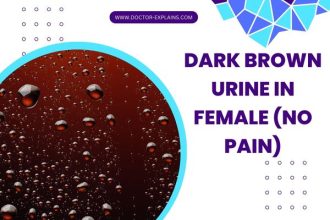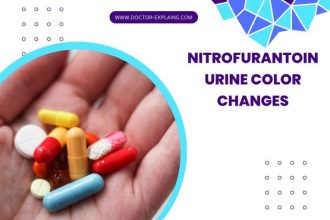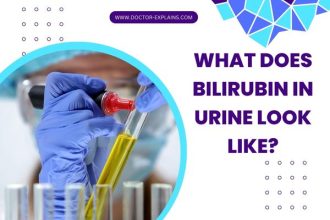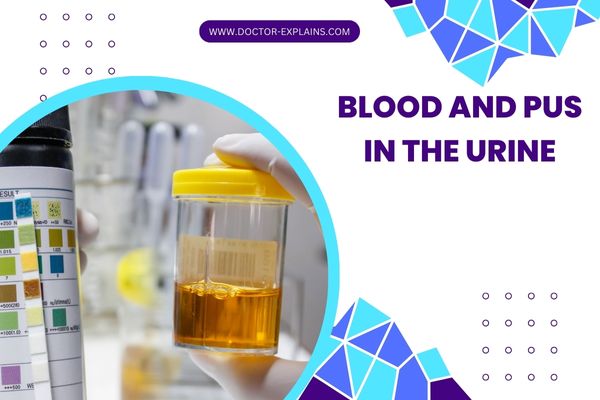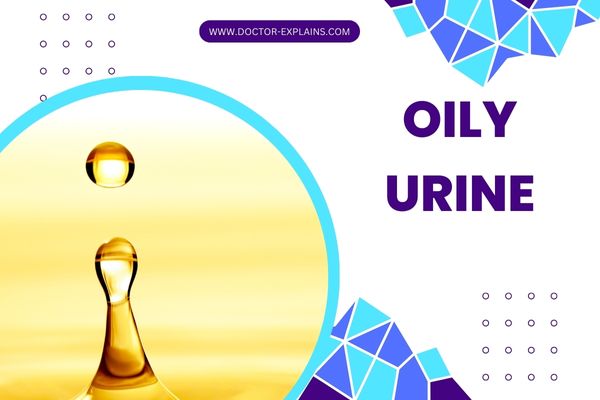Dark yellow urine, even with drinking a lot of water, can arise from factors such as certain foods, medications, or supplements. Additionally, underlying medical conditions, like liver or kidney issues, could contribute to this change in urine color. It’s crucial to consult a healthcare professional for proper evaluation and diagnosis.
Urine color can vary within a range of colors, typically from pale yellow to amber and dark yellow urine.
These variations are considered normal and can result from different factors such as hydration state, diet, medications, and supplements.
Even with drinking a lot of water, dark yellow urine can be due to various dietary factors, medications, or health conditions.
The table below summarizes the common causes and conditions that cause dark yellow urine even with drinking a lot of water:
| Cause of dark yellow urine (despite of good hydration) | Characteristic Features |
|---|---|
| Supplements and medications | Recent intake of B-complex vitamins (especially riboflavin or vitamin B2), rifampin, or phenazopyridine. Also, drugs that cause cholestasis may cause the condition. |
| Dietary factors | Recent ingestion of Carrots, beets, blackberries, and certain artificial food colorings |
| Gilbert Syndrome | Mild jaundice, occasional fatigue |
| Hemolytic anemias | Fatigue, weakness, pallor, rapid heartbeat, jaundice |
| Acute liver conditions | Abdominal pain, jaundice, nausea, vomiting |
| Chronic liver conditions and cirrhosis | Jaundice, fatigue, abdominal pain, swelling, easy bruising |
| Biliary obstruction | Jaundice, abdominal pain, fever, itching |
| Glomerulonephritis | Foamy urine, swelling, high blood pressure, decreased urine output |
| Hematuria (RBCs in urine) | Pain during urination, lower back pain, blood clots in urine |
| Hemoglobinuria | dark yellow or tea-colored urine associated with anemia, some genetic and autoimmune diseases. |
| Rhabdomyolysis | Muscle pain, weakness, swelling |
| Porphyria (rare) | Dark brown urine during acute attacks, abdominal pain, muscle pain, seizures |
| Melanuria (rare). | Dark brown to black urine associated with malignant melanoma or pigment-related disorders |
The causes of dark yellow urine despite drinking water:
1. Certain supplements and medications
Supplements and medications are among the most common causes of dark yellow urine that doesn’t improve after drinking water.
Always review any medication or supplement you’ve taken recently, like:
- B-complex vitamins (particularly riboflavin or vitamin B2)
- Vitamin C (in high doses)
- Beta-carotene
- Carotene-rich foods (e.g., carrots, sweet potatoes, pumpkin)
- Rifampin (an antibiotic)
- Phenazopyridine (a urinary tract analgesic)
- Warfarin (a blood thinner)
- Laxatives containing senna or cascara
- Iron supplements
In cases of taking a drug or supplement, you will typically have dark urine without other symptoms suggesting a urinary tract disease.
You should also consider drugs that may cause bile stasis in the liver (drug-induced cholestasis), as these drugs may also cause mild jaundice and dark yellow or light brown urine.
Common medications include:
- Antibiotics such as Amoxicillin-clavulanic, erythromycin, azithromycin, and trimethoprim-sulfamethoxazole.
- Phenytoin (anticonvulsant)
- Anabolic steroids (e.g., testosterone, nandrolone)
- Estrogens and oral contraceptives
- Tamoxifen (breast cancer treatment)
- Methimazole (antithyroid medication)
- Propylthiouracil (antithyroid medication)
- Allopurinol (gout treatment)
- Methotrexate (chemotherapy and immunosuppressive drug)
- Cyclosporine (immunosuppressive drug)
Consulting with a healthcare provider to discuss adjustments to medication, dosage, or alternative treatments. Urine color should normalize once the medication is altered or discontinued.
2. Food-related factors
- Cause: Foods like carrots can result in dark yellow or even orange urine.
- Symptoms: Dark yellow urine without any other associated issues or discomfort.
- Diagnosis: Review the patient’s eating habits and recent food intake to pinpoint potential culprits.
- Treatment: Modifying the diet to decrease or eliminate consumption of foods responsible for the color change in urine. Urine color should return to normal once the food is not consumed any longer.
3. Gilbert Syndrome
Gilbert syndrome, a mild liver disorder, affects approximately 3% to 12% of people and is caused by a genetic mutation that leads to decreased activity of the enzyme responsible for metabolizing bilirubin – a waste product created during the breakdown of red blood cells.
Despite being relatively common, the condition is typically harmless and doesn’t necessitate treatment except for adhering to a healthy lifestyle and avoiding triggers that could worsen symptoms.
- Symptoms: Dark yellow urine, mild jaundice, and occasional fatigue.
- Diagnosis: Blood tests to measure bilirubin levels and confirm the presence of Gilbert Syndrome.
- Treatment: No specific treatment is required; however, patients should maintain a healthy lifestyle and avoid triggers that could worsen symptoms, such as stress or dehydration.
Learn more about Gilbert syndrome.
4. Hemolytic anemias
- Cause: Rapid breakdown of red blood cells leads to increased bilirubin levels, resulting in dark yellow to light brown urine.
- Symptoms: Dark yellow urine, fatigue, weakness, pallor, rapid heartbeat, and jaundice.
- Diagnosis: Blood tests to measure red blood cell count, hemoglobin, and bilirubin levels, as well as other tests to identify the particular type of hemolytic anemia.
- Treatment: Treatment depends on the type and severity of hemolytic anemia and may include blood transfusions, medications to suppress the immune system or increase red blood cell production, or treatment of the underlying cause.
5. Other less probable causes:
A. acute liver conditions
Many conditions, such as Inflammation (acute hepatitis), infection (such as acute viral hepatitis), or injury to the liver, can lead to elevated bilirubin levels, causing dark yellow urine.
- Common symptoms: Dark yellow urine, abdominal pain, jaundice, nausea, and vomiting.
- Diagnosis: Blood tests, imaging studies, and possibly a liver biopsy to identify the specific liver condition.
- Treatment: Treatment depends on the specific liver condition but may include medications, supportive care, or hospitalization.
B. Long-term liver conditions and cirrhosis
Advanced liver disease and liver cirrhosis can cause an increase in bilirubin levels, leading to dark yellow to light brown urine.
Common conditions include:
- Chronic viral hepatitis (HBV, HCV) and related cirrhosis.
- Autoimmune hepatitis.
- Primary biliary cholangitis.
- Primary sclerosing cholangitis.
- Hemochromatosis.
Symptoms:
Dark yellow urine, jaundice, fatigue, abdominal pain, swelling, and easy bruising.
Diagnosis:
Blood tests, imaging studies, and potentially a liver biopsy to confirm cirrhosis or chronic liver disease.
Treatment:
Management of the underlying liver condition, including medications, lifestyle changes, and potentially a liver transplant in severe cases.
C. Biliary obstruction
- Cause: Blockage in the bile ducts can cause dark yellow to light brown urine due to elevated bilirubin levels.
- Symptoms: Dark yellow urine, jaundice, abdominal pain, fever, and itching.
- Diagnosis: Blood tests, imaging studies, and potentially an endoscopic procedure to identify the cause of the obstruction.
- Treatment: Treatment depends on the cause of the obstruction and may include medications, endoscopic procedures, or surgery.
D. Glomerulonephritis
- Cause: Inflammation of the kidney’s filtering units can cause dark yellow to light brown urine due to the presence of blood or excess protein.
- Symptoms: Dark yellow urine, foamy urine, swelling, high blood pressure, and decreased urine output.
- Diagnosis: Blood and urine tests, imaging studies, and potentially a kidney biopsy to confirm glomerulonephritis.
- Treatment: Treatment depends on the underlying cause and severity but may include medications to control blood pressure, inflammation, or immune system response, and dietary changes.
E. Hematuria (RBCs in urine)
The presence of blood in urine is a very common condition related to a wide variety of conditions.
Blood present in the urine can cause dark yellow to light brown urine.
Common causes include:
- Kidney or bladder stones,
- UTI,
- exercise-induced hematuria.
- bladder cancer
- urinary bladder endometriosis, and others.
Symptoms:
- Dark yellow, red, or pink urine,
- pain during urination,
- lower back pain,
- and possibly blood clots in the urine.
Diagnosis:
- Urinalysis, blood tests,
- imaging studies,
- and potentially a cystoscopy or kidney biopsy to identify the cause of hematuria.
- Treatment: Treatment depends on the underlying cause of hematuria and may include medications, surgical intervention, or other therapies.
F. Hemoglobinuria.
The presence of free hemoglobin in one’s urine, known as hemoglobinuria, can lead to a dark yellow or even brownish hue.
This condition arises from the breakdown of red blood cells, or hemolysis, which might be due to various factors such as infections, autoimmune disorders, or genetic conditions like thalassemia and sickle cell anemia.
When red blood cells are destroyed, the released hemoglobin enters the bloodstream and is subsequently filtered by the kidneys, ultimately appearing in the urine.
Dark yellow urine may co-occur with other symptoms like exhaustion, paleness, and jaundice, depending on the severity and root cause of hemoglobinuria.
G. Other less common causes:
- Rhabdomyolysis: A condition where muscle tissue breaks down and releases a protein called myoglobin into the bloodstream, which can then be filtered by the kidneys and cause dark brown urine.
- Porphyria: A group of rare genetic disorders that affect heme production, which can lead to dark brown urine during acute attacks.
- Melanuria: The presence of melanin or melanin precursors in the urine, which can cause dark brown to black urine, often associated with malignant melanoma or other pigment-related disorders.
When to worry and see a doctor
If you experience persistent dark yellow urine despite adequate water intake, consider seeking medical advice. Here are some indications that it may be time to consult a healthcare professional:
- Persistent dark yellow urine for days or weeks despite of good hydration and drinking water.
- Associated burning urination, frequent urination, or sudden urge to pee.
- Associated abdominal pain, nausea, or vomiting.
- Associated jaundice or clay-colored stools.
- Unexplained weight loss.
- Unexplained fatigue or fever.
- If you have a medical history of kidney or liver disease.
Diagnosis of the cause of persistent dark yellow urine
A healthcare professional will typically start with a detailed medical history and physical examination to evaluate the patient’s symptoms. They may also order laboratory tests, such as blood tests and urinalysis, to assess kidney and liver function and identify any abnormalities. Depending on the results, additional tests, such as imaging studies or a biopsy, may be required to pinpoint the underlying cause of the dark yellow urine.

